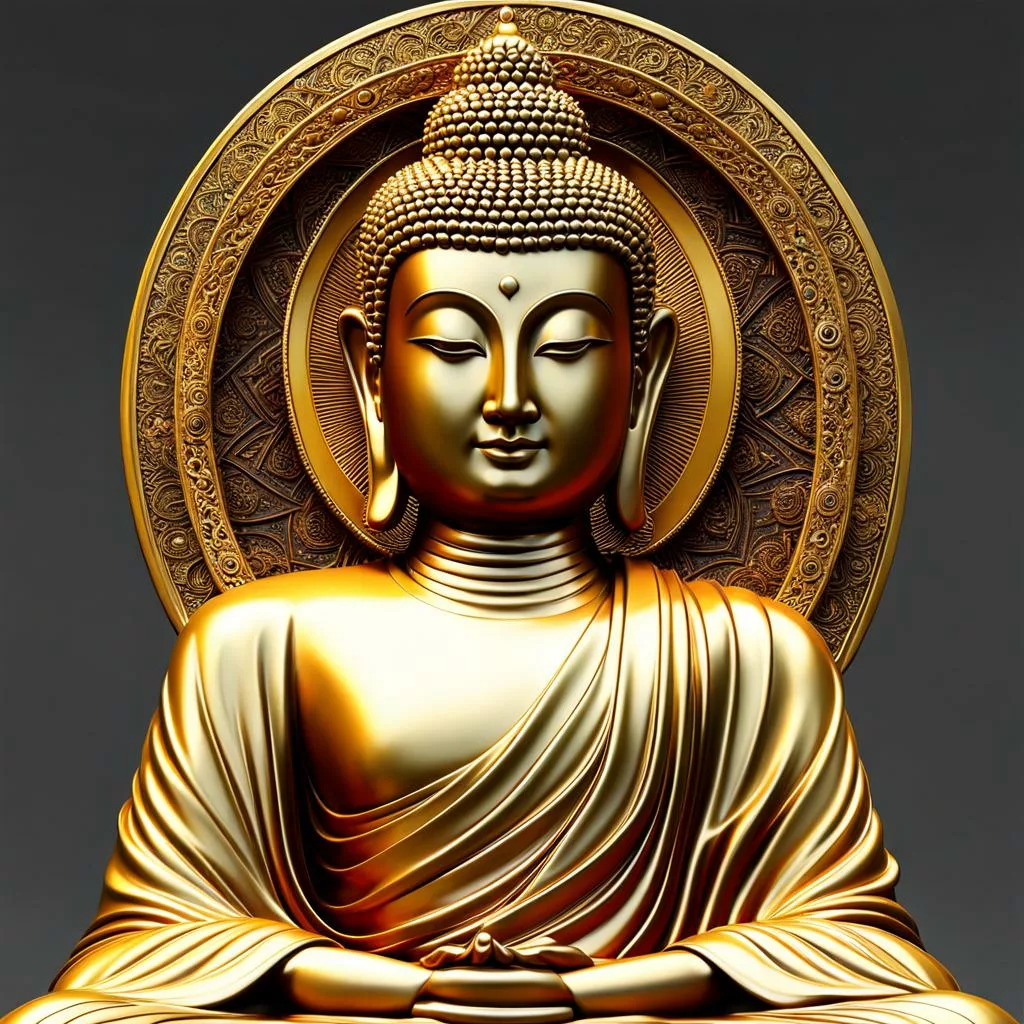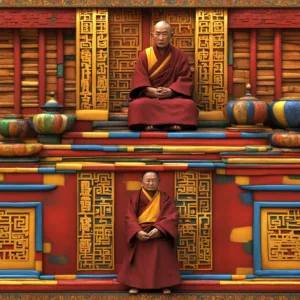
Shakyamuni Buddha means Awakened Sage of the Shakya clan. He was the historical founder of Buddhism, born in Bodhgaya. He attained enlightenment at the age of 35, taught the dharma until 80. He entered paranirvana in Kushinagar.
I wanted to write a post on Shakyamuni Buddha to inspire people. I hope it helps.
Secrets of Meditation for Anxiety
Like millions of people, you may have suffered from anxiety for years. Meditation, yoga, peaceful music – it never works. It takes too long, and it’s not stable. Why? Because peace is treated as a cause for freedom, but it’s not – it’s the result. The cause to free yourself from anxiety is completely different.
Click now to Overcome Anxiety for good.
Table of Contents
Summary: Shakyamuni Buddha
Central Node: Shakyamuni Buddha (Siddhartha, also Gautama)
Properties:
- Lived: 6th-4th centuries BCE (approximate)
- Occupation: Founder of Buddhism
- Title: Buddha (Awakened One)
- Place of Birth: Lumbini, Nepal (Sacred Site within Lumbini Zone, Rupandehi District, Nepal)
- Teachings: Four Noble Truths, Eightfold Path
- Core Beliefs: Non-violence (ahimsa), Compassion (karuna), Nirvana (liberation from suffering)
- Language(s) Spoken: Magadhi Prakrit (Indo-Aryan language)
Related Entities:
- Religion: Buddhism (Theravada, Mahayana, Vajrayana)
- Concepts: Suffering (dukkha), Karma, Rebirth (samsara), Nirvana, Dependent Origination (pratītyasamutpāda)
- Followers: Buddhists (monks, nuns, laypeople)
- Texts: Tripitaka (Pali Canon), Mahayana Sutras, Tibetan Book of the Dead (Bardo Thodol)
Events:
- Early Life: Sheltered upbringing in the Shakya royal clan
- Great Renunciation: Leaving his palace life at age 29 to seek truth
- Six Years of Asceticism: Practicing severe self-denial and meditation with gurus
- Attainment of Enlightenment: Achieving enlightenment under the Bodhi tree in Bodh Gaya at age 35
- First Sermon: Sharing the Four Noble Truths with his five former companions in Sarnath
- Forty-Five Years of Teaching: Traveling and teaching throughout northern India
- Parinirvana: Entering into complete nirvana at age 80 in Kushinagar
Influences:
- Hinduism (Vedic traditions, Upanishads)
- Jainism (ahimsa, asceticism)
Legacy:
- Buddhism became one of the world’s major religions, with over 500 million followers today.
- Buddhist philosophy has influenced numerous schools of thought, including ethics, meditation practices, and theories of mind.
- Buddhist art, architecture, and literature have had a profound impact on Asian cultures.
Buddha Shakyamuni Early Life
According to Buddhist legends, Shakyamuni Buddha, formerly known as Siddhartha Gautama, was born in Lumbini, in what is now Nepal, to royal parents of the Shakya clan. He lived a sheltered life in his palace and was unaware of the suffering that existed in the world. However, as a young man, he ventured outside the palace walls and encountered illness, old age, and death. These experiences deeply disturbed him and sparked a quest to understand the nature of suffering and how to overcome it. This led him to renounce his royal life and begin his journey as an ascetic seeker of truth. ░
Path to Enlightenment, becoming Buddha Shakyamuni
According to Buddhist tradition, Siddhartha Gautama, the Buddha, attained enlightenment after leaving his sheltered life and witnessing the suffering of the world. He then spent years living as an ascetic, practicing severe self-denial and meditation. After failing to find satisfaction through asceticism, he sat under a Bodhi tree and vowed not to rise until he achieved enlightenment. There, he attained enlightenment and became known as the Buddha.
Teachings of Shakyamuni Buddha
The Four Noble Truths
The core of Shakyamuni Buddha’s teachings lies in the Four Noble Truths. These truths outline the nature of suffering, its cause, the possibility of ending it, and the path that leads to liberation.
- The First Noble Truth: The Truth of Suffering (Dukkha)
This truth acknowledges the pervasiveness of suffering in human life. Suffering isn’t just physical pain, but also includes dissatisfaction, impermanence, and a sense of disconnection. Birth, illness, old age, and death are all considered forms of suffering.
- The Second Noble Truth: The Truth of the Cause of Suffering (Samudaya)
The second truth identifies the root cause of suffering as craving (tanha) and clinging (upadana). Craving arises from desires for pleasure, possessions, and permanence in a world that is inherently impermanent. We cling to things and experiences, leading to frustration and disappointment when they inevitably change or disappear.
- The Third Noble Truth: The Truth of the End of Suffering (Nirodha)
This truth offers a glimmer of hope. It states that suffering is not inevitable and that liberation from suffering is possible. This liberation, called Nirvana, is a state of perfect peace and freedom from craving and clinging.
- The Fourth Noble Truth: The Path to the End of Suffering (Magga)
The final truth outlines the path, also known as the Noble Eightfold Path, leading to the end of suffering. This path is a practical guide for living a life free from craving and achieving enlightenment. It consists of eight interconnected practices called the eightfold path.
How to meditate like a yogi
and enter profound samadhi
Shakyamuni buddhas Eightfold Path
The Four Noble Truths diagnose the problem of suffering and offer the possibility of a cure. But how do we actually achieve this liberation? Shakyamuni Buddha provided a practical roadmap known as the Noble Eightfold Path. This path isn’t a series of linear steps, but rather eight interconnected practices that work together to cultivate wisdom, ethical conduct, and mental discipline. These three aspects are often referred to as the Threefold Training.
Here’s a breakdown of the eight elements of the Noble Eightfold Path:
1. Right View (Sammā Ditthi): This involves developing a clear understanding of the Four Noble Truths. It’s about seeing reality as it truly is, recognizing the impermanent nature of life and the causes of suffering.
2. Right Intention (Sammā Sankappa): This means cultivating wholesome intentions and motivations. We replace negativity with thoughts of generosity, kindness, and non-attachment.
3. Right Speech (Sammā Vācā): Ethical communication is key. We abstain from lying, gossip, harsh language, and frivolous chatter. Instead, we strive for truthful, kind, and helpful speech.
4. Right Action (Sammā Kammanta): This translates to ethical conduct in our daily lives. We avoid actions that cause harm to ourselves or others, such as killing, stealing, and sexual misconduct. Living with integrity and compassion is the goal.
5. Right Livelihood (Sammā Ajiva): This principle encourages earning a living in a way that aligns with the other right actions. We avoid professions that involve harming others or exploiting them. Ideally, our work should contribute to the well-being of ourselves and society.
6. Right Effort (Sammā Vayama): This involves cultivating mental discipline. We actively work to develop positive qualities, eliminate negative thoughts and behaviors, and maintain a state of mental focus.
7. Right Mindfulness (Sammā Sati): This focuses on cultivating present-moment awareness. We train our attention to observe our thoughts, feelings, and bodily sensations without judgment. Developing mindfulness allows us to see through cravings and attachments.
8. Right Concentration (Sammā Samadhi): This involves developing focused attention through meditation practices. By calming the mind and cultivating concentration, we gain a deeper understanding of ourselves and reality.
The Eightfold Path is a lifelong journey of self-discovery and transformation. By cultivating these practices, we can gradually weaken our cravings and attachments, leading towards a more peaceful and liberated state of being.



Table of Teachings by Shakyamuni Buddha
| Category | Teaching | Description |
|---|---|---|
| Core Principles | Four Noble Truths | The foundation of Buddhist thought, outlining the nature of suffering (dukkha), its cause, the end of suffering (nirvana), and the path to its end. |
| Eightfold Path | A practical guide for living a life free from suffering. It consists of eight interconnected practices leading to wisdom, ethical conduct, and mental discipline. | |
| Anatta (Not-Self) | The concept that there is no permanent, unchanging self or soul. We are a collection of constantly changing mental and physical processes. | |
| Ethical Conduct | Pancasila (Five Precepts) | Basic moral guidelines for Buddhists: 1. Do not kill. 2. Do not steal. 3. Do not engage in sexual misconduct. 4. Do not lie. 5. Do not consume intoxicants. |
| Karma | The law of cause and effect. Our actions (both intentional and unintentional) have consequences that shape our future experiences. | |
| Meditation | Vipassana (Insight Meditation) | Developing present-moment awareness through observing thoughts, feelings, and bodily sensations without judgment. |
| Samatha (Tranquility Meditation) | Cultivating calmness and focus through various techniques, often focusing on the breath. |
Additional Teachings
- Dependent Origination (Pratītyasamutpāda): Explains how suffering arises through a chain of interconnected causes and conditions.
- The Three Jewels: The refuge for Buddhists: The Buddha (Teacher), the Dharma (Teachings), and the Sangha (Community).
- Skilful Means (Upāya-kauśalya): The Buddha’s ability to tailor his teachings to the specific needs and understanding of his audience.
- Compassion (Karuna): A deep empathy and concern for the suffering of others.
- Loving-kindness (Metta): Unconditional well-wishing and goodwill for all beings.
Note: This table is not exhaustive, but provides a starting point for understanding the core teachings of Shakyamuni Buddha.
Shakyamuni Buddha Paranirvana
The story of Shakyamuni Buddha’s Paranirvana, also known as the Buddha’s final passing, is a significant event in Buddhism. Here’s a telling of the tale:
The Final Journey:
After traveling and teaching tirelessly for forty-five years, Shakyamuni Buddha, then eighty years old, reached the town of Kushinagar in northern India. He knew his time in the physical world was nearing its end. He announced to his disciples that he would soon enter Parinirvana.
A Simple Meal:
One evening, a wealthy metalworker named Chunda offered the Buddha and his followers a meal of mango. Unfortunately, the mangoes were not fully ripe and caused the Buddha to become ill. Despite the discomfort, the Buddha remained calm and accepted his fate with equanimity.
Last Instructions:
Knowing his end was drawing near, the Buddha gathered his disciples and delivered his final instructions. He emphasized the importance of taking refuge in the Dharma (teachings) and the Sangha (community) after his departure. He reminded them to rely on their own practice and not to seek guidance from external sources.
Under the Sala Trees:
Weakened but composed, the Buddha requested to be taken to a grove of Sala trees outside the town. He lay down on his right side on a simple bed of leaves, with his head facing north. His disciples, filled with grief, gathered around him.
Entering Parinirvana:
As the sun began to set, Shakyamuni Buddha entered a deep meditative state. Accounts describe a radiant light emanating from his body. One by one, his disciples, both male and female, approached him to pay their respects and ask for forgiveness for any shortcomings. The Buddha offered words of encouragement and comfort to each.
Final Words:
With his remaining strength, the Buddha uttered his final words: “Anicca vata sankhara, Upadukkha vedana. Sankharatta nirodho Nirvana” (All compounded things are impermanent. Suffering arises from clinging. The cessation of clinging is Nirvana).
Parinirvana:
Following these words, Shakyamuni Buddha entered Parinirvana. A great earthquake shook the earth, and a radiant light filled the sky. While his physical body remained, it no longer held the spark of consciousness. His disciples, though filled with sorrow, also experienced a sense of peace knowing their teacher had attained liberation from suffering.
Legacy:
The Buddha’s Parinirvana marks the end of his physical presence in the world. However, his teachings and the path he laid out continue to guide countless people on the journey to enlightenment. The event serves as a reminder of the impermanence of all things and the possibility of liberation from suffering.

May all beings be happy
May all beings be peaceful
May all beings be safe
May all beings awaken to the light of their true nature
May all beings be free







